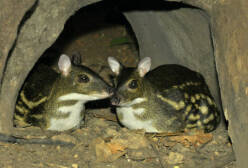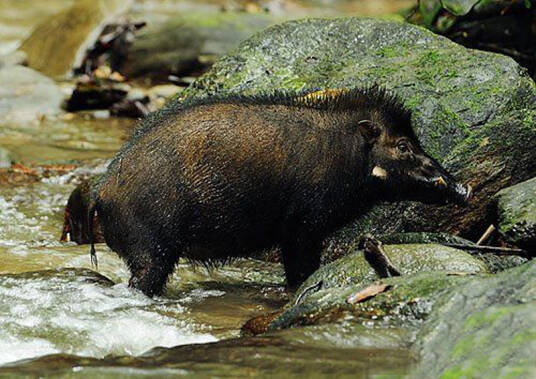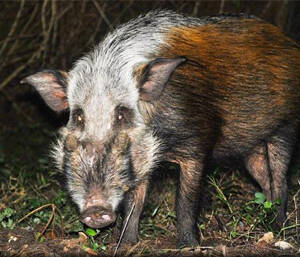
Tragulus javanicus
Tragulus javanicus,Javan Chevrotain、Java Mousedeer、Javan Mousedeer、Kanchil、Lesser Mouse Deer, Chevrotain de Java、Petit tragul malais
Javan Mousedeer (scientific name: Tragulus javanicus) English Javan Chevrota···

Moschiola meminna
Moschiola meminna, White-spotted Chevrotain,Chevrotain,Indian Mouse Deer,Indian Spotted Chevrotain,White-spotted Mousedeer,Tragule d'Inde, Meminna
Spotted Mouse Deer (scientific name: Moschiola meminna) English White-spotte···

Moschiola kathygre
Moschiola kathygre
The yellow-striped mouse deer (scientific name: Moschiola kathygre) has no s···

Moschiola indica
Moschiola indica,Indian Chevrotain、Indian Mouse Deer、Indian Mousedeer、Indian Spotted Chevrotain
Indian Chevrotain (scientific name: Moschiola indica) is also known as India···

Hyemoschus aquaticus
Hyemoschus aquaticus, Water Chevrotain,Chevrotain Aquatique, Antilope Amizclero Enano de Agua, Hirschferkel
Water Chevrotain [shuǐ xī lù] (scientific name: Hyemoschus aquaticus) Eng···

Tayassu pecari
Tayassu pecari
White-lipped Peccary (scientific name: Tayassu pecari) has 5 subspecies.Whit···

Catagonus wagneri
Catagonus wagneri,Chacoan Peccary,Tagua
The Chacoan Peccary (Catagonus wagneri) has no subspecies. When it was first···

Pecari tajacu
Pecari tajacu,Collared Peccary,Collared peccary, collared pig, collared peccary
Collared Peccary (scientific name: Pecari tajacu) has 14 subspecies. Peccary···

Pecari maximus
Pecari maximus,Pecari Gigante,Giant wild boar
Pecari maximus (scientific name: Pecari maximus) is also known as Pecari Gig···

Sus verrucosus
Sus verrucosus,Javan pig、Sanglier pustule,Javan warty pig, warty wild pig
Javan wild boar (scientific name: Sus verrucosus) foreign name Javan pig, Sa···

Sus scrofa
Sus scrofa, Wild Boar、Eurasian Wild Pig、Ryukyu Islands Wild Pig, Sanglier、Sanglier d'Eurasie,Jabalí, Schwarzwild、Wildschwein, Zerleg Gakhai
Eurasian wild boar (scientific name: Sus scrofa) English Wild Boar, Eurasian···

Sus philippensis
Sus philippensis,Philippine Warty Pig,Philippine warthog
Philippine Warty Pig (scientific name: Sus philippensis) has two subspecies.···

Sus oliveri
Sus oliveri,Oliver's Warty Pig,Mindoro Warty Pig, Oliver's Warty Pig
Mindoro wild boar (scientific name: Sus oliveri) is also known as Oliver'···

Sus celebensis
Sus celebensis,Sulawesi Warty Pig,Celebes wild boar
Sulawesi Warty Pig (scientific name: Sus celebensis) has three subspecies.Th···

Sus cebifrons
Sus cebifrons,Visayan warty pig,Visayan warty pig, curly-haired wild boar
Visayan warty pig (scientific name: Sus cebifrons) is a species endemic to t···

Sus bucculentus
Sus bucculentus,ndo-chinese Warty Pig、Heude's Pig、 Vietnam Warty Pig,Vietnamese wild boar, big-mouthed wild boar
Indochinese wild boar (scientific name: Sus bucculentus) is also known as In···

Porcula salvania
Porcula salvania,Pygmy Hog, Sanglier nain、Sanglier pygmée, Jabalí Enano、Jabalí Pigmeo, Nal Gahori、Takuri Borah, Sano Banel,Pygmy pig, pygmy boar
Porcula salvania (Pygmy Hog in English, Sanglier nain, Sanglier pygmée in F···

Sus barbatus
Sus barbatus,Bearded Pig,Western Bearded Pig
Borneo Bearded Pig (scientific name: Sus barbatus) is also known as Bearded ···

Sus ahoenobarbus
Sus ahoenobarbus,Palawan Bearded Pig
Palawan Bearded Pig (Sus ahoenobarbus) has no subspecies. The Palawan Bearde···

Potamochoerus larvatus
Potamochoerus larvatus,Bushpig,Jungle Pig
Masked wild boar (scientific name: Potamochoerus larvatus) is also known as ···

Potamochoerus porcus
Potamochoerus porcus,Red River Hog,West African bush pig, tufted pig, red river hog
Red River Hog (scientific name: Potamochoerus porcus) is also known as Red R···
